An understanding of the basics of naval strategy is vital to making sense of the logic behind the construction of the battleship, and also to understanding naval warfare today. Modern naval strategy began with Alfred Thayer Mahan’s seminal book The Influence of Sea Power upon History. He outlined how control of the sea had granted Britain victory over her enemies during most of the 18th century, and theorized that a power which could control the sea would have outsize influence over events on land. Events since then have borne him out.

Alfred Thayer Mahan
Even today, the sea remains the best way of moving large quantities of heavy objects about the globe. Over 90% of global trade goes by sea. Despite American airlift capabilities, any large-scale deployment of US troops would require equipment and supplies to be transported by sea. Two schools of thought have developed to deal with these basic facts: sea denial and sea control.
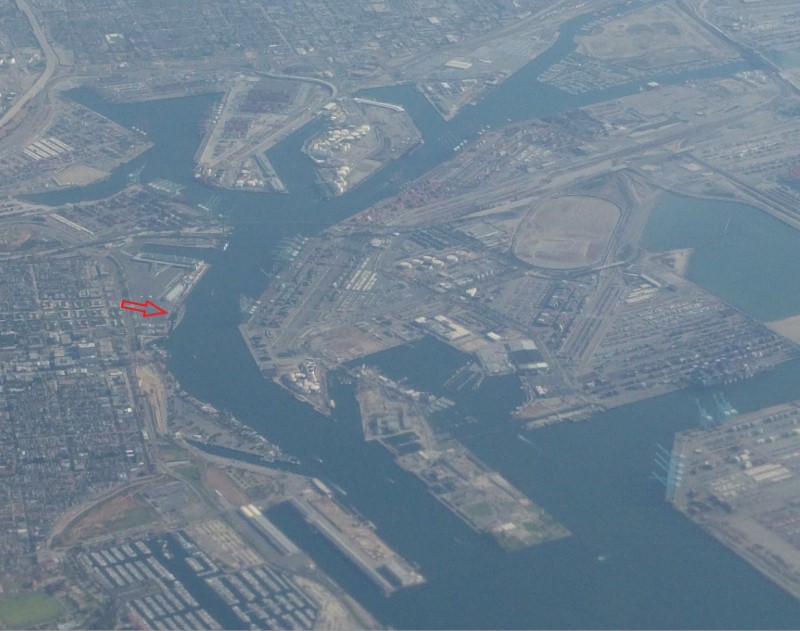
The Port of Los Angeles, arrow to Iowa
Sea denial is primarily focused on impeding the enemy’s use of the sea. The classic version of this is a combination of coastal defense forces and commerce raiding. The coastal defenses prevent landings or bombardments, while the commerce raiders degrade the enemy’s use of the sea for commerce or support of military operations. The most famous example of this in action is the German U-boat campaigns of the world wars, which were quite effective at disrupting Allied logistics efforts. The coastal defense role was filled by fortifications, mines, light naval units, aircraft, and even the High Seas Fleet to some extent. The doctrine, however, dates back much further. Until Mahan, it was the core of American naval strategy, most notably during the War of 1812, and it has become more feasible over the last 200 years as the ability of forces on land to influence events at sea has grown.1
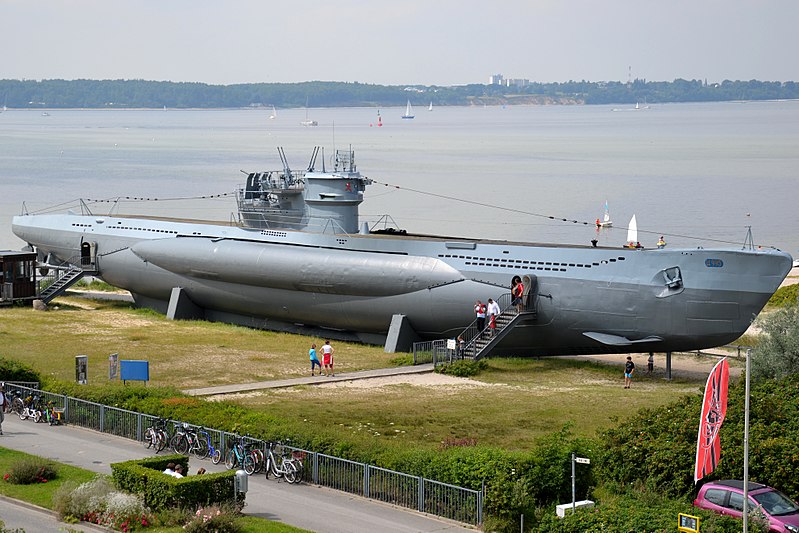
U-995, a preserved WWII U-boat
Sea control is the strategy of choice for a maritime power, dedicated to making sure that enemy efforts at sea denial fail, and allowing the power in question to make full use of the sea for commerce and war. While a denial-focused enemy may be able to inflict attrition on enemy shipping and naval forces, control of the sea allows a power to blockade its enemy, cutting them off from the benefits of maritime trade.2 Naval forces have also become increasingly capable of projecting power ashore on the flanks of an enemy, in the form of bombardment, landing, or providing support to allies. Obviously, sea control is the superior choice for power projection, but it is also expensive, and is best implemented by powers that do not have to support the cost of a standing army to deter enemies on its borders.
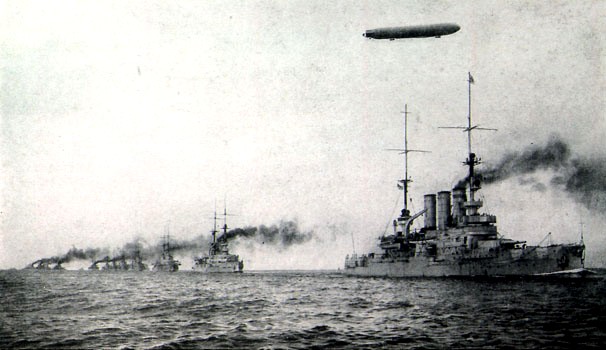
The High Seas Fleet
Mahan theorized that the most effective way to seize control of the sea was to destroy the enemy fleet in a decisive battle, which required a concentrated fleet of capital ships. A weaker power could keep its force as a “fleet in being”, tying down strong naval forces to prevent it getting out and seriously damaging sea control. The obvious examples are again drawn from Germany during both world wars, first the High Seas Fleet and later Tirpitz. While it appears on the surface that the ships used in this role were ineffective, in fact the presence of the Germans tied down large numbers of British ships, which could not be transferred elsewhere3 or risked in European waters, for instance in the Baltic.

Tirpitz off Norway
In a situation short of general war, the flexibility of naval forces is vital. Unlike land and land-based air forces, naval forces are capable of deploying at great distances from a base, giving a power the ability to take action without the permission of a local partner.4 Paradoxically, this actually can make it easier to draw said partners in. Because they do not have the ability to completely veto the action, refusing to take part is ultimately an empty symbol. This significantly reduces the political benefits of a veto to the partner, and makes them more likely to join.
The flexibility of naval forces is important in another way. Deployments on land require diplomatic approval in a way naval deployments don’t, which brings with it diplomatic consequences. An example of this is in Korea, where the US ground troops are important as a means of making sure that the US cannot ignore an attempt by the North Koreans to come south. Naval forces are easier to deploy and easier to withdraw, as we saw in Lebanon in 1982.
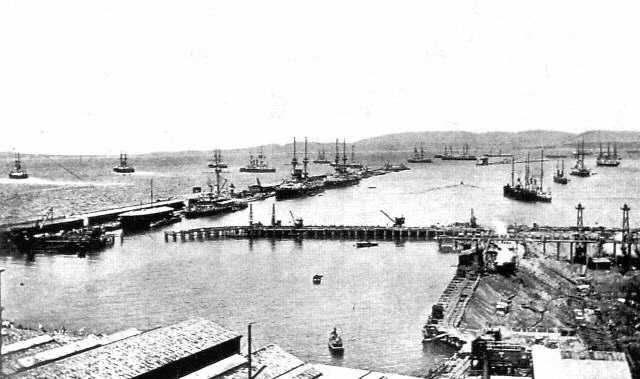
The docks of Gibraltar, 1880s
Geography plays an important part in all of this. While the sea surface itself is without geography,5 naval forces are dependent on shore facilities for support. In the age of sail, this was mostly for supply and repair, while coaling stations defined naval geography during the early age of steam, giving the British a huge advantage over other powers. The US, lacking such facilities, built bigger, longer-ranged ships. Today, we’ve created forward bases in Europe and Japan, to allow our ships to spend more time on station, and replenishment ships to allow ships to spend more time at sea.
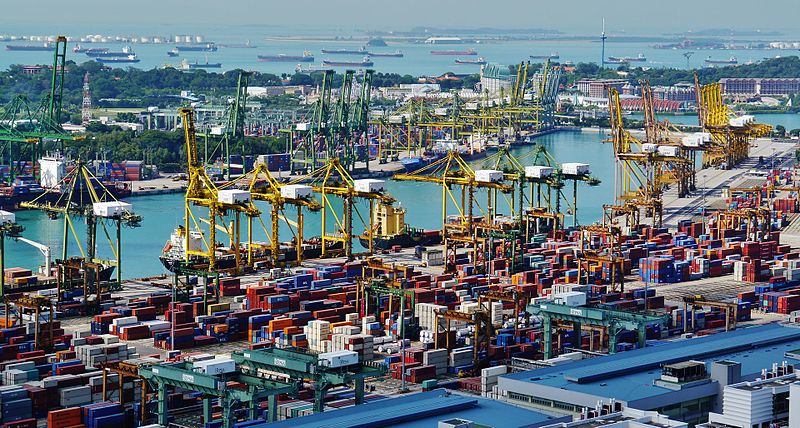
Ships off Singapore
Moreover, a huge fraction of global trade flows through a few key choke points. A century ago, Jackie Fisher described “Five keys [that] lock up the world! Singapore. The Cape. Alexandria [Suez]. Gibraltar. Dover.” Today, we’d have to add the Strait of Hormuz, but the basic truth remains the same. Control of trade through these critical areas gives immense power, and it is in the interest of a maritime power to have that control, or at least to have great influence over how it is used.
This is a very high-level overview, and I’ve had to skip over a tremendous amount of detail. This post was mostly based off of Norman Friedman’s book Seapower as Strategy, and I’d encourage you to get a copy if you want more detail.
1 It’s lately reemerged under the heading of Anti Access/Area Denial or A2/AD. I’ve covered why I don’t think this is true today in the “Why the Carriers Are Not Doomed” series. ⇑
2 Yes, it is a bit odd that sea denial involves denying the sea less thoroughly than the alternative. These are the standard terms, and I didn’t make them up. ⇑
3 For instance, to face off against the Japanese in 1941. ⇑
4 Aerial refueling has made it possible for bombers from the continental US to strike anywhere in the world, but the refueling planes need overseas bases, which are only slightly less vulnerable than the bomber bases themselves. This problem can be circumvented by the sufficiently determined, but only at great cost and effort. ⇑
5 Things change considerably when we start to look at undersea warfare, but that’s a topic for another day. ⇑

Comments
It is not, of course, strictly correct to say that the sea is without geography. It just looks that way on large-scale maps. In fact, local conditions can be very important. Weather is a major factor in operations and design; subsurface topography, such as reefs and shoals and currents, can have a major impact on operations; in some parts of the ocean water turns white and solid for part of the year.
Obviously most of this is of more concern at high latitudes or in near-shore operations, but even out in the open ocean there are interesting areas of lower water depth (e.g., the Dogger Bank in the North Sea).
To be really pedantic in my defense, I only said the surface. Weather isn’t really part of geography, and shallow water isn’t technically part of the surface either.
To be less pedantic, you have a point. Particularly about ice, although that’s only very rarely a major consideration. And I was trying to do a quick overview anyway.
Do you remember www.nationstates.net? With enough participation, we could game very limited scenarios where Medium Island Nation and Isthmus Federation engage in strategic competition, turns being something like 5 years maybe.
This is a great thread regardless, and I’m looking forward to reading it.
Is that true? The reason suez (and Panama) are such vital choke points is to a large extent because the North East and North West passages aren’t free and clear.
First, I was speaking tactically, not strategically. Yes, ice plays a part in strategic geography.
Second, I think you overestimate the effects of open Northeast and Northwest Passages. If I’m trying to go from the US East Coast to, say, Asia, you’re going to want to go through Panama instead of all the way around Canada. It’s probably better than going around Cape Horn, but that’s not a particularly high bar to clear. Suez is a tiny bit less clear-cut, but it’s still probably better.
I might be confused by the way the 16th-18th century guys HOPED the northern passages would be useful, rather than how they actually would.
There are a growing number of air line routes over the poles (both North and South) but these also ignore coastlines in a way that ships can’t (or at least shouldn’t).
I ran some numbers in Google Earth. Going from New York to LA, I got 5120 nm through Panama. A simple Northwest Passage (staying out of the Beaufort Sea) gave 7747 nm. But that’s probably a bad metric to use. Let’s try New York to Shanghai. (Mostly pointless because they’ll just bring the ship into LA and ship to NY using rail, but whatever.) A Panama route gave 10820 nm. Northwest passage give 8231 nm, which is an impressive reduction. I’d guess you could get similar reductions for a northeast passage from Europe to the Far East. The big problem is that both routes are unreliable. They have political and environmental issues you don’t see through Panama or Suez.
Those are called great circles. The first approximation is that east-west lines are closer together towards the poles, so it makes sense to try to cross them as close to the poles as possible. But yes, ships can’t just ignore geography the way airplanes can.